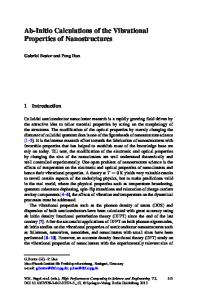Ab Initio Study of Switching Properties of Photochromic Dithienylethene Molecules
- PDF / 182,278 Bytes
- 5 Pages / 612 x 792 pts (letter) Page_size
- 64 Downloads / 403 Views
0965-S09-41
Ab Initio Study of Switching Properties of Photochromic Dithienylethene Molecules Anders Odell and Anna Delin Materials Science and Engineering, Royal Institute of Technology, Brinellvägen 23, Stockholm, 100 44, Sweden
ABSTRACT We report an ab initio study of a photochromic dithienylethene derivative. The mechanisms for switching between open and closed conformations are investigated based on total energy calculations for the ground and first excited state. An explanation for the central ring closure based on relaxation of the excited state is presented. INTRODUCTION The demand of modern society for ever faster mass communication and information processing has driven device miniaturization for the last four decades. Molecular electronics is envisioned as a possible next step in this effort. It is motivated by the fundamental limitations of conventional semi-conductor based electronics. Molecular electronics is usually taken to mean the design and manufacturing of electronic devices and applications where organic molecules work as the fundamental functioning unit. It involves the measurement and manipulation of electronic response and transport in molecules attached to conducting leads. Organic molecules have the advantages of inherent small sizes, endless chemical diversity and low-temperature low cost manufacturing. Suggested applications are biological sensors, disposable electronics, displays and data storage and processing. The seminal idea in 1974 by Aviram and Ratner sparked a strong multidisciplinary effort [1]. Experiments have since led to the demonstration of negative differential resistance and switching properties [2], and rectification [3] in two terminal devices where a molecule is coupled to two contacts. Switching allows for the design of devices with transistor-like behavior, where it is possible to switch between states with different conductance. The switching mechanism can be achieved by different means in different setups. In this paper we investigate the switching properties of photochromic dithienylethene derivatives. Such molecules change their conformation in solution when acted upon by light. The central benzene ring in the closed isomer opens under visible light (400-700 nm) while the reverse ring closure of the open isomer occurs under UV irradiation (
Data Loading...










